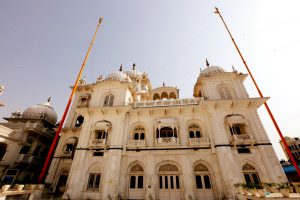Patna Sahib Gurudwara – Takht Sri Patna Sahib, A Sacred Sikh Pilgrimage in Bihar
Introduction
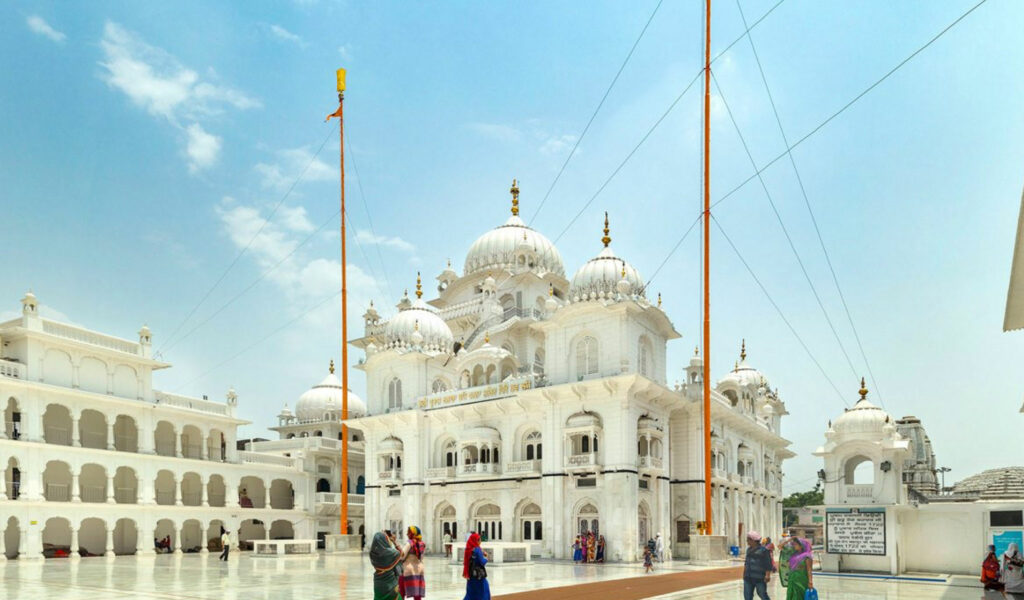
India is a land of faiths, spiritual journeys, and timeless heritage. Among its countless sacred sites, Patna Sahib Gurudwara—also known as Takht Sri Harmandir Sahib Ji or Takht Sri Patna Sahib—holds a special place in Sikhism. Located in Patna, Bihar, this revered gurudwara marks the birthplace of the tenth Sikh Guru, Guru Gobind Singh Ji, who was born here in 1666.
Recognized as one of the five Takhts (seats of authority) in Sikhism, Patna Sahib is not only a holy shrine but also a center of spiritual learning, devotion, and community service. Every year, thousands of devotees and travelers visit Patna to seek blessings, explore its history, and immerse themselves in the gurudwara’s divine aura.
Historical Significance of Patna Sahib Gurudwara
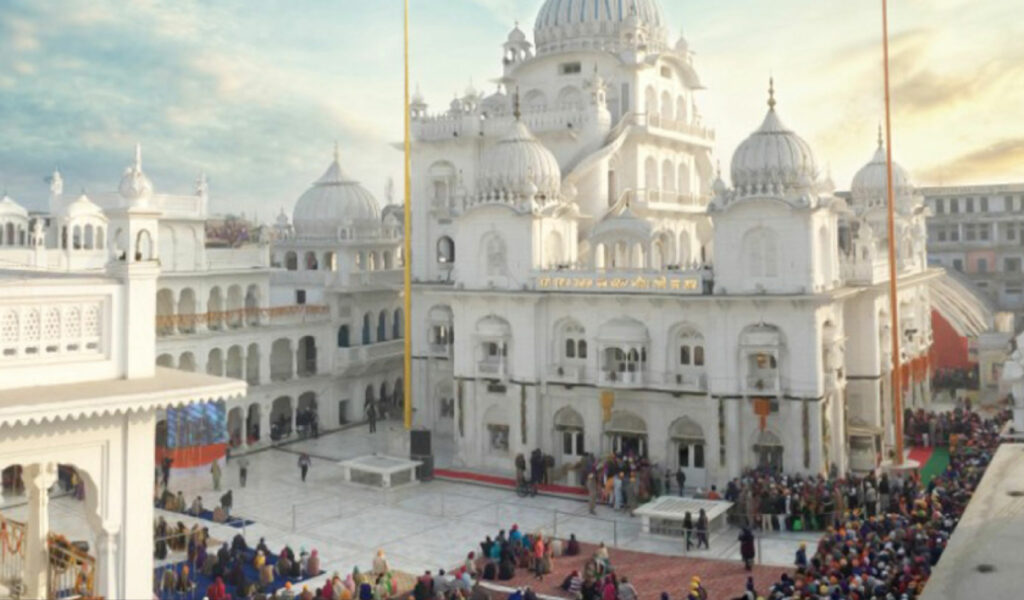
India has long been celebrated as a land of faiths, spiritual journeys, and timeless heritage, where temples, mosques, churches, monasteries, and gurudwaras stand as living testaments to devotion and unity. Among its countless sacred landmarks, one that holds immense reverence in Sikhism is the Patna Sahib Gurudwara. Also known as Takht Sri Harmandir Sahib Ji or Takht Sri Patna Sahib, this holy site in Patna, Bihar is regarded as a jewel of Sikh heritage and spirituality.
The history of Patna Sahib Gurudwara is deeply connected with the birth of the tenth Sikh Guru, Guru Gobind Singh Ji, who was born here in 1666. Guru Gobind Singh Ji, remembered as a saint, warrior, poet, and philosopher, reshaped Sikhism by establishing the Khalsa Panth and inspiring millions with his teachings of bravery, equality, and service to humanity. This makes Patna Sahib not only a place of worship but also a destination of historical and spiritual importance.
What elevates the significance of Takht Sri Patna Sahib further is its status as one of the five Takhts (seats of Sikh authority). In Sikhism, Takhts are supreme centers that guide the community on both spiritual and temporal matters. Thus, Patna Sahib is not just a sacred birthplace but also a living seat of Sikh governance, faith, and tradition.
Every year, thousands of devotees and travelers undertake a Sikh pilgrimage in Bihar to visit this holy shrine. The gurudwara welcomes people from all walks of life who come to seek blessings, listen to Gurbani kirtan, and participate in langar (the free community kitchen). Beyond being a religious journey, a visit to Takht Sri Patna Sahib is also a chance to explore the rich culture and history of Bihar, making it a must-visit destination for both devotees and heritage travelers.
Architecture of Takht Sri Patna Sahib
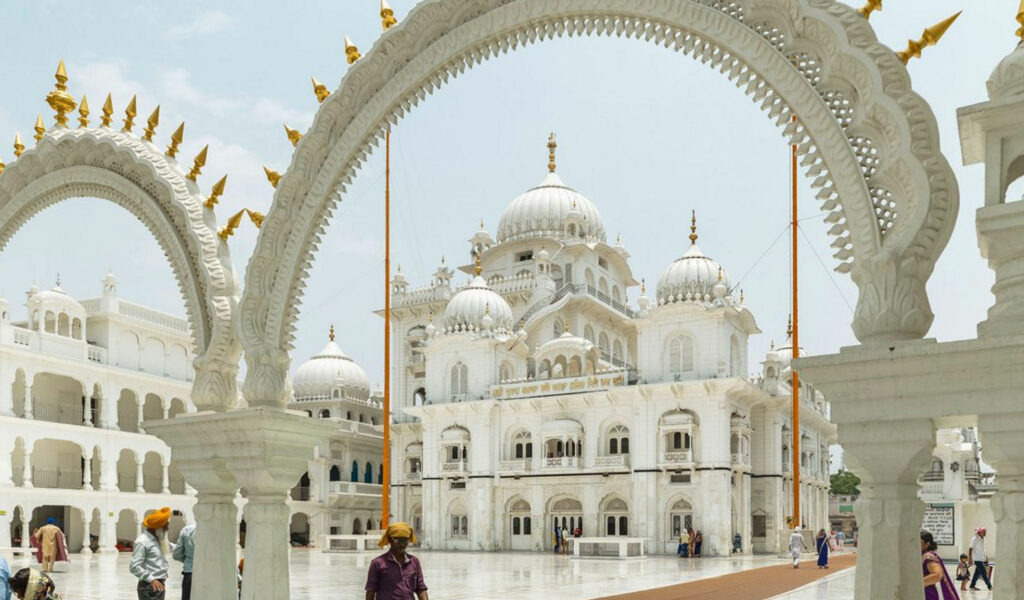
The architecture of Patna Sahib Gurudwara is a blend of spiritual symbolism, Mughal influences, and Sikh traditions, making it both a sacred space and an artistic marvel. Built originally by Maharaja Ranjit Singh and later restored over time, the shrine beautifully captures the devotion and reverence associated with the birthplace of Guru Gobind Singh Ji. Every aspect of the gurudwara’s structure carries not only aesthetic value but also deep spiritual significance.
Key Architectural Features and Their Symbolism
White Marble Structure – Symbol of Purity – The gurudwara is built using pristine white marble, a material often associated with peace, eternity, and divine purity. In Sikhism, white reflects truth and humility—virtues that form the foundation of Guru Gobind Singh Ji’s teachings. As sunlight reflects on the marble walls and flooring, it creates an aura of serenity, reminding devotees of spiritual clarity and inner peace.
Golden Domes – Radiance of Spiritual Power – The shimmering golden domes crowned with sacred kalash (pinnacles) symbolize divine authority and eternal faith. Gold, in Sikh architecture, represents the eternal light of the Guru and the radiance of spirituality. The domes also make the shrine visible from afar, guiding devotees much like a beacon of hope and enlightenment.
Arched Entrances and Carvings – Fusion of Cultures – The Mughal-inspired arches and intricate carvings at the entrances highlight a fusion of Islamic artistic elegance with Sikh simplicity. This reflects India’s cultural inclusiveness, where diverse influences came together to create timeless heritage. The arches serve not just as gateways into the gurudwara but as portals into spiritual awakening.
Sanctum (Darbar Sahib) – The Heart of Devotion – At the core of Takht Sri Patna Sahib lies the sanctum, or Darbar Sahib, where the Guru Granth Sahib Ji (the holy scripture of Sikhism) is enshrined. This sacred chamber also preserves relics of Guru Gobind Singh Ji—his weapons, cradle, and garments. The sanctum represents the seat of eternal wisdom, where the Guru’s teachings guide devotees even today.
Prayer Hall – Symbol of Equality – The expansive prayer hall resonates with Gurbani kirtan, uniting people from all walks of life. In Sikhism, the sangat (congregation) is a reminder of equality and brotherhood, where no one is high or low. Sitting together, devotees embody Guru Ji’s vision of a society free from discrimination and divisions.
Sarovar (Holy Tank) – Spiritual Cleansing – Many Sikh shrines are built around a sarovar, and Patna Sahib is no exception. The sacred water body is more than a physical feature—it symbolizes purification of the soul and the washing away of ego. Devotees often sit near the sarovar in reflection, experiencing peace and stillness in its calm waters.
Religious Importance of Patna Sahib Gurudwara
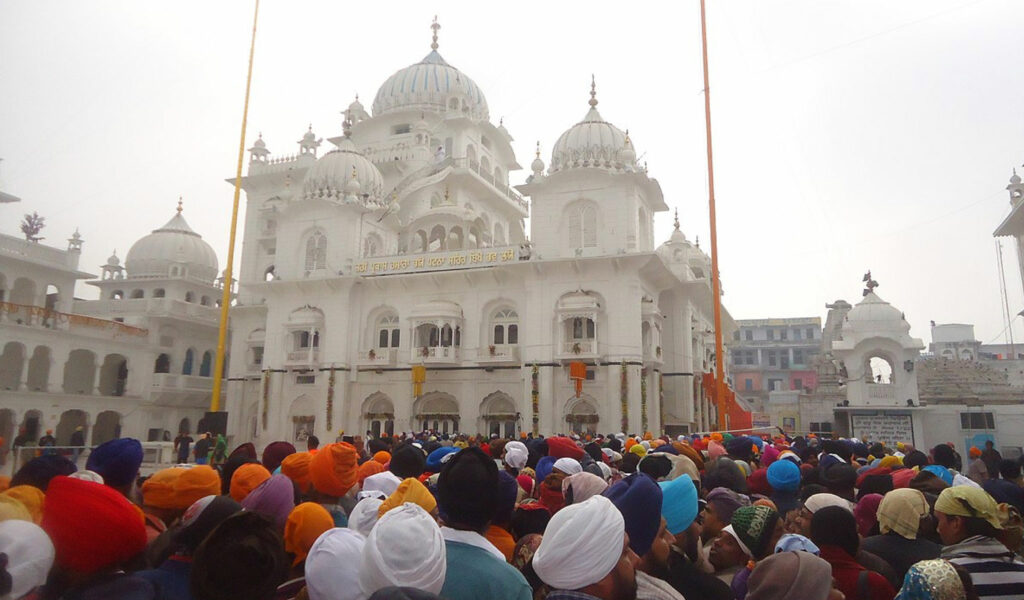
The religious importance of Patna Sahib Gurudwara cannot be overstated. It is not only a place of worship but also a living embodiment of Sikh values, history, and authority. As one of the five Takhts of Sikhism, the shrine represents both spiritual sanctity and administrative power, guiding the Sikh community across the globe.
Why Patna Sahib Gurudwara Holds Unparalleled Significance
A Seat of Sikh Authority – In Sikhism, a Takht is much more than a gurudwara—it is a seat of spiritual and temporal authority. Decisions on key religious matters, interpretations of Sikh teachings, and guidance for the community are issued from these Takhts. Takht Sri Patna Sahib, being one of these five sacred seats, plays a vital role in preserving and promoting Sikh traditions. Its influence extends beyond Bihar, connecting Sikh communities worldwide to a central authority rooted in the birthplace of Guru Gobind Singh Ji.
Guru Gobind Singh Ji’s Birthplace – The gurudwara is revered as the birthplace of Guru Gobind Singh Ji, the tenth Guru of Sikhism, born here in 1666. This makes it one of the most sacred destinations in the Sikh faith. Guru Gobind Singh Ji is remembered not only as a spiritual teacher but also as a warrior, poet, and philosopher who laid the foundation of the Khalsa Panthin 1699. His teachings of bravery, equality, justice, and selfless service continue to inspire millions, and Patna Sahib stands as a constant reminder of his legacy. Visiting the shrine is akin to walking in the footsteps of the Guru himself.
A Center of Spiritual Pilgrimage – For Sikhs around the world, undertaking a pilgrimage to Patna Sahib Gurudwara is as significant as visiting the Golden Temple in Amritsar or Hazur Sahib in Nanded. Each Takht holds its own spiritual aura, but Patna Sahib is unique because it is the birthplace of a Guru. The gurudwara is not just a destination for prayer but also a journey of inner transformation—devotees gather here to recite Gurbani kirtan, participate in langar (community kitchen), and immerse themselves in a collective spirit of devotion.
Festivals Celebrated at Patna Sahib Gurudwara
The festivals of Patna Sahib Gurudwara transform the shrine into a vibrant center of devotion, faith, and unity. During these occasions, thousands of devotees from across India and abroad gather at the Takht to honor Sikh Gurus and their teachings. The gurudwara is adorned with lights and flowers, while the air fills with the soulful sounds of Gurbani kirtan(devotional hymns), echoing Guru Ji’s timeless wisdom.
Major Festivals at Takht Sri Patna Sahib
Prakash Parv – Birth Anniversary of Guru Gobind Singh Ji
The most important festival celebrated at Patna Sahib Gurudwara is the Prakash Parv, commemorating the birth of Guru Gobind Singh Ji in 1666. This grand event, usually held in December–January, draws lakhs of devotees from around the world.
The celebrations last for several days, including Akhand Path (continuous recitation of Guru Granth Sahib Ji), kirtan sessions, and special prayers.
A massive Nagar Kirtan (religious procession) is organized through the streets of Patna, with devotees singing hymns, performing Gatka (Sikh martial arts), and spreading messages of unity and service.
The langar (community kitchen) serves thousands of visitors round the clock, symbolizing Sikhism’s ideals of equality and sharing.
This festival not only honors Guru Ji’s birth but also reminds devotees of his legacy of courage, sacrifice, and service to humanity.
Baisakhi – Formation of the Khalsa
Another major festival at Takht Sri Patna Sahib is Baisakhi, celebrated in April. It marks the historic day in 1699 when Guru Gobind Singh Ji founded the Khalsa Panth at Anandpur Sahib.
At Patna Sahib, the day begins with early morning prayers and the recitation of Gurbani.
Special diwans (congregational gatherings) are held to highlight the significance of Khalsa values—courage, discipline, and brotherhood.
The festival is filled with a spirit of devotion, festivity, and communal harmony, as devotees reaffirm their faith in the Guru’s teachings.
Guru Nanak Jayanti – Celebrating the First Guru
Patna Sahib Gurudwara also celebrates Guru Nanak Jayanti, the birth anniversary of Guru Nanak Dev Ji, the founder of Sikhism. The event is observed with kirtan, lectures on Guru Nanak’s philosophy of equality and service, and processions that spread his universal message: “Ik Onkar – God is One.”
Other Gurpurabs – Honoring Sikh Gurus
Apart from these major events, the gurudwara also observes the anniversaries (Gurpurabs) of other Sikh Gurus. These include Guru Arjan Dev Ji’s martyrdom day, Guru Tegh Bahadur Ji’s sacrifices, and other important milestones in Sikh history. Each Gurpurab is marked by prayers, kirtans, and langars, ensuring that the Guru’s life and teachings remain alive in the hearts of devotees.
Best Time to Visit Patna Sahib Gurudwara
Though the gurudwara is open year-round, the best times to plan a visit include:
•December – January: For Guru Gobind Singh Ji’s Prakash Parv celebrations.
•October – March: Pleasant winter weather makes sightseeing easier.
•April: To experience Baisakhi festivities.
Summer months can be hot in Bihar, so travelers prefer the cooler seasons.
Travel Guide – How to Reach Patna Sahib Gurudwara
Patna Sahib Gurudwara is easily accessible by air, rail, and road:
•By Air: The nearest airport is Jay Prakash Narayan International Airport (approx. 15 km away). Taxis and autos are available for direct travel to the gurudwara.
•By Rail: Patna Sahib Railway Station is just 2 km from the shrine. Patna Junction (central station) is 12 km away.
•By Road: The gurudwara is well-connected by city buses, autos, and taxis. Patna’s road network links it to major cities like Gaya, Varanasi, Ranchi, and Kolkata.
Tips for Visitors
1.Cover your head with a scarf or turban before entering.
2.Remove footwear and wash hands before entering the prayer hall.
3.Sit in the main hall during Gurbani kirtan to experience spiritual peace.
4.Don’t miss the langar, where free meals are served to all visitors.
5.Photography may be restricted inside the sanctum—respect the rules.
6.Morning and evening Ardas (prayers) are the most serene times to visit.
Nearby Attractions in Patna
If you are visiting Takht Sri Patna Sahib, you can also explore other attractions in Patna:
•Patna Museum – Historical artifacts and Buddhist relics.
•Golghar – A unique granary offering panoramic city views.
•Kumhrar – Archaeological remains of the Mauryan capital, Pataliputra.
•Agam Kuan – An ancient well with links to Emperor Ashoka.
•Mahavir Mandir – A famous temple dedicated to Lord Hanuman.
These nearby attractions make a trip to Patna both spiritual and cultural.
Accommodation Near Patna Sahib Gurudwara
Patna offers a wide range of accommodations for devotees and travelers:
•Gurudwara Sarai (Rest Houses): Affordable stay options within or near the gurudwara complex.
•Hotels in Patna: Ranging from budget to luxury, options include Hotel Maurya, Lemon Tree Premier, and Ginger Patna.
•Guesthouses & Dharamshalas: For pilgrims looking for simple lodging.
It’s best to book accommodation early during festival times, as the city sees a surge of visitors.
FAQs About Patna Sahib Gurudwara
Q1. What is Patna Sahib Gurudwara famous for?
Patna Sahib Gurudwara, also known as Takht Sri Harmandir Sahib Ji, is famous as the birthplace of Guru Gobind Singh Ji, the tenth Sikh Guru. It is one of the five Takhts of Sikhism, making it a highly revered pilgrimage site.
Q2. Which Guru was born in Patna Sahib?
Guru Gobind Singh Ji, the tenth Sikh Guru, was born in Patna Sahib on 22 December 1666.
Q3. Who built Patna Sahib Gurudwara?
The gurudwara was built by Maharaja Ranjit Singh in the 18th century to honor the birthplace of Guru Gobind Singh Ji.
Q4. What are the main relics preserved in Patna Sahib Gurudwara?
The shrine houses sacred relics of Guru Gobind Singh Ji including his cradle, weapons, handwritten Hukamnamas, and sacred garments.
Q5. When is the best time to visit Patna Sahib Gurudwara?
The gurudwara is open year-round, but the best time is during Guru Gobind Singh Ji’s Prakash Parv (December–January) and Baisakhi (April) when the shrine hosts grand celebrations.
Q6. How far is Patna Sahib Gurudwara from Patna Airport?
The gurudwara is approximately 15 km from Jay Prakash Narayan International Airport in Patna. Taxis and autos are easily available for direct travel.
Q7. Is there accommodation available near Patna Sahib Gurudwara?
Yes, devotees can stay in Sarai (rest houses) within the gurudwara premises or choose from a range of hotels and guesthouses in Patna.
Conclusion
The Patna Sahib Gurudwara is not just a Sikh pilgrimage site—it is a beacon of India’s cultural and spiritual legacy. As the birthplace of Guru Gobind Singh Ji and one of the five Takhts of Sikhism, it attracts both devotees and history lovers alike.
From its serene architecture and priceless relics to its vibrant festivals and peaceful langar, the shrine offers a complete spiritual journey. Whether you are exploring heritage tourism in Bihar or seeking inner peace, Takht Sri Patna Sahib promises an experience filled with devotion, history, and harmony.

